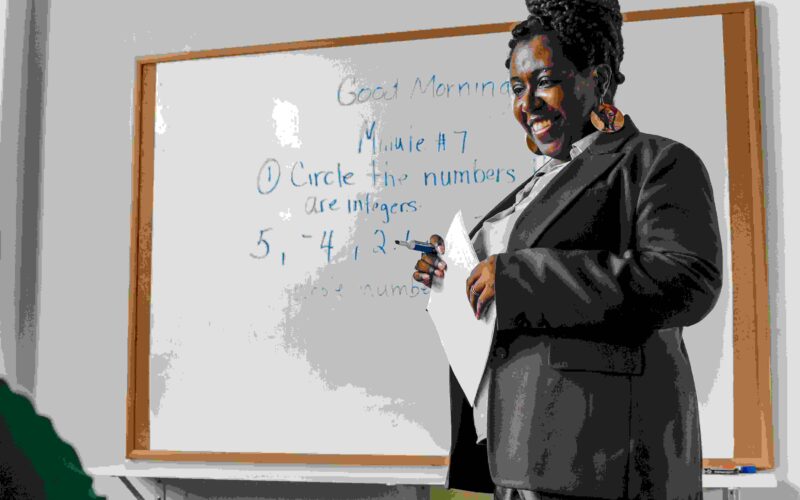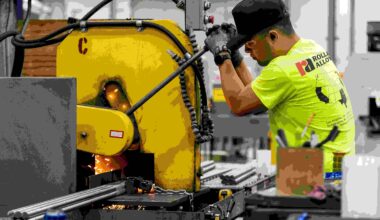Are you interested in teaching jobs in America for foreigner (I mean as a foreigner)? This post will guide on the best path to follow.
Across the United States, schools are opening their doors wider than ever to international educators.
The reason is because there is a growing demand for qualified teachers, especially in high-need subjects like mathematics, science, and special education.
Teaching jobs in America are not just vacancies waiting to be filled, they represent a bridge between cultures, perspectives, and experiences.
U.S. schools are realizing the value that international teachers bring not only their expertise but also their unique worldviews that enrich students understanding of global society.
For a foreigner passionate about shaping young minds, teaching in America is both a career path and a life-changing journey.
But this journey isn’t merely about landing a job. It’s about stepping into a new culture, learning new educational methods, and becoming part of a system that thrives on diversity.
For many, it is the chance to contribute meaningfully while building a better future for themselves and their families.
This post will guide you through on the best guide to secure teaching jobs in America for foreigner and what it truly means to teach in America as a foreigner, the opportunities that await, the challenges to prepare for, and the rewarding adventure of building a teaching career abroad.
The Landscape of Teaching in America
The American education system is vast, diverse, and complex, offering a wide spectrum of opportunities for teachers both at home and abroad.
Unlike many countries that operate under a single national system, the U.S. is divided into 50 states, each with its own education board, policies, and certification requirements.
Within this system, there are public schools, private schools, and charter schools and each offering different approaches to learning and teaching.
Public schools, funded by local and state governments, make up the majority and employ the largest number of teachers.
Private schools operate independently, often with smaller class sizes, while charter schools blend elements of both systems and continue to expand across the country.
In recent years, America has faced a serious teacher shortage, particularly in specialized subjects like mathematics, science, technology, and special education.
Many rural and urban districts struggle to find qualified educators, creating a gap that international teachers are increasingly helping to fill.
This shortage has opened the door for foreigners who are passionate about education to step in and make a difference.
But beyond filling vacancies, U.S. schools recognize the immense value that international teachers bring.
They enrich classrooms by offering diverse cultural perspectives, teaching styles, and global experiences that prepare students for a more interconnected world.
For foreigners, this landscape represents not just employment, but the chance to join a system actively seeking new voices.
Understanding this context is crucial. it helps you see not just the jobs available, but the vital role you play in shaping America’s classrooms.
Pathways Into Teaching jobs in America for Foreigners
Teaching jobs in America for foreigner begins with understanding the available pathways.
Unlike many professions, teaching in the U.S. often requires specific legal and professional steps, and knowing these options is the key to starting strong.
The most common routes for teaching jobs in America for foreigner are
• J-1 Visa
J-1 Visa, offered through cultural exchange programs that bring international teachers to U.S. classrooms for three to five years.
This pathway is popular because it allows educators to share their culture, teach full-time, and gain invaluable international experience.
• H-1B Visa
Another route is the H-1B Visa, designed for specialty occupations, which can apply to teachers in high-demand subjects such as mathematics, science, and special education. While competitive, it offers a potential path to long-term career growth in the United States.
• Credentials transfer and certification
In addition to visas, foreign-trained teachers must also address credential transfer and certification.
Each U.S. state sets its own requirements, which may involve evaluating your degrees, completing professional development courses, or passing state certification exams.
These steps ensure that teachers meet local educational standards while still leveraging their international expertise.
• English Proficiency and Cultural Adaptability
Equally important is English proficiency and cultural adaptability. While your teaching skills are crucial, thriving in an American classroom also requires effective communication, flexibility, and openness to new teaching styles.
Schools value foreign teachers not just for their knowledge, but for their ability to connect with diverse student populations.
By navigating these pathways thoughtfully, teaching jobs in America for foreigner can be really achieved by foreign aspirator in America.
Life in the American Classroom
Stepping into an American classroom for the first time can feel both exciting and overwhelming for foreign teachers.
Classrooms in the U.S. are often lively, student-centered environments where learning goes beyond textbooks.
Unlike in some countries where teachers rely heavily on lecture-based methods, American education emphasizes interaction, group projects, technology integration, and critical thinking.
Teachers are expected to engage students actively, encouraging them to ask questions, debate ideas, and apply concepts to real-life situations.
Technology plays a central role in modern classrooms. From smart boards and tablets to digital learning platforms, U.S. schools integrate tech into lessons to make learning more interactive and efficient.
This means foreign teachers must quickly adapt to these tools while also blending in their own teaching styles. Student diversity is another defining feature.
American classrooms bring together children from different cultural, linguistic, and social backgrounds. This diversity creates an enriching environment, but it also requires teachers to be sensitive, adaptable, and inclusive in their approach.
Classroom management is equally important. While respect for teachers exists, the dynamic is less formal than in many countries.
Students are encouraged to express themselves freely, and teachers are expected to balance authority with approachability. Parent involvement is also notable, with families often playing an active role in their children’s education.
For foreign educators, life in the American classroom is an opportunity to grow, share cultural perspectives, and impact young learners in profound ways while simultaneously learning from a system that thrives on innovation and diversity.
Common Challenges and How to Navigate Them
Teaching jobs in America for foreigner is a rewarding experience, but it does not come without challenges. One of the first hurdles many educators face is
• Culture shock.
Classroom interactions, student behavior, and even the informality of addressing teachers by their first names can feel unusual.
The best way to navigate this is with openness, observe, adapt, and gradually blend your teaching style with the expectations of the American system.
• Teaching standards and workload expectations
Another challenge lies in different teaching standards and workload expectations. U.S. schools often emphasize lesson planning, technology use, and individualized support for students, which can feel overwhelming at first.
Foreign teachers can manage this by seeking mentorship from colleagues, attending professional development workshops, and using online resources tailored for international educators.
• Housing and community integration
Outside the classroom, issues such as housing and community integration may also arise. Adjusting to a new lifestyle, finding affordable accommodation, and creating a support system in an unfamiliar environment can be tough.
The key is connecting with local teacher associations, immigrant communities, and cultural networks that provide both guidance and companionship.
• Homesickness
Homesickness is a common emotional challenge. Leaving behind family, friends, and familiar traditions can weigh heavily.
But staying connected through virtual calls, celebrating cultural holidays abroad, and building friendships within the school community can ease the transition.
While these challenges are real, they are also manageable. Every difficulty becomes an opportunity to grow stronger, more adaptable, and more confident.
With resilience and support, foreign teachers can thrive while turning obstacles into stepping stones for success.
The Rewards and Long-Term Opportunities
While the challenges of teaching jobs in America for foreigner are undeniable, the rewards make the journey worthwhile.
For many foreign educators, one of the most immediate benefits is personal growth.
• Immersing yourself in a new culture
Immersing yourself in a new culture, adapting to innovative teaching methods, and navigating a diverse classroom environment sharpens your skills and broadens your perspective as an educator.
These experiences often make teachers more versatile, confident, and globally competitive.
• Career advancement opportunities
Beyond personal development, there are tangible career advancement opportunities. American schools frequently encourage professional growth through workshops, advanced certifications, and graduate programs.
Many international teachers take advantage of these resources to deepen their expertise and expand their qualifications. Over time, this can open doors to leadership roles, curriculum design positions, or even academic research opportunities.
• Financial stability
Financial stability is another reward, with competitive salaries and benefits depending on the state and district.
More importantly, long-term opportunities such as transitioning from temporary visas to permanent residency exist for those who wish to make the U.S. their permanent home.
Teachers on visas like H-1B may find pathways to green cards, allowing them to build a lasting career in America.
• Impact on students’ lives
But perhaps the most fulfilling reward is the impact on students’ lives. Sharing your knowledge, culture, and experiences inspires young learners and prepares them to embrace a globalized world.
For many foreign teachers, this sense of purpose knowing they are shaping future generations while building their own future is the most profound reward of all.
Conclusion
Teaching jobs in America as foreigner is more than a career move, it is a life changing adventure filled with growth, challenges, and unforgettable experiences.
From the moment you step into a U.S. classroom, you become part of a system that values diversity, innovation, and the exchange of ideas.
The journey may begin with paperwork, certifications, and cultural adjustments, but it ultimately leads to something far greater like the chance to impact lives while transforming your own.
This experience is not simply about filling vacancies or earning a paycheck, it is about building bridges between cultures.
Every lesson you teach, every perspective you share, and every story you bring from your home country enriches students in ways that extend far beyond academics.
For many young learners, having an international teacher is their first window into a broader world, and that influence stays with them long after they leave the classroom.
The road is not without obstacles. Adapting to new standards, balancing expectations, and managing life far from home require resilience.
And those who persevere discover that each challenge is also an opportunity to grow stronger and more adaptable.
If you are passionate about education and ready to embrace change, America may be the next chapter in your teaching journey.
The opportunities are waiting but it takes courage to step forward. Begin researching programs, connect with teaching networks, and prepare yourself for an adventure that could redefine both your career and your life.
Did you find this article on teaching jobs in America for foreigner very helpful? Let us know in the comment section.
Similar Post
Best jobs in America California for immigrants that pays well






